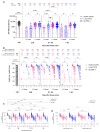Immune Response after SARS-CoV-2 Infection with Residual Post-COVID Symptoms
- PMID: 37766091
- PMCID: PMC10535557
- DOI: 10.3390/vaccines11091413
Immune Response after SARS-CoV-2 Infection with Residual Post-COVID Symptoms
Abstract
Many patients develop post-acute COVID syndrome (long COVID (LC)). We compared the immune response of LC and individuals with post-COVID full recovery (HC) during the Omicron pandemic. Two hundred ninety-two patients with confirmed COVID infections from January to May 2022 were enrolled. We observed anti-SARS-CoV-2 receptor-binding domain immunoglobulin G, surrogate virus neutralization test, T cell subsets, and neutralizing antibodies against Wuhan, BA.1, and BA.5 viruses (NeuT). NeuT was markedly reduced against BA.1 and BA.5 in HC and LC groups, while antibodies were more sustained with three doses and an updated booster shot than ≤2-dose vaccinations. The viral neutralization ability declined at >84-days after COVID-19 onset (PC) in both groups. PD1-expressed central and effector memory CD4+ T cells, and central memory CD8+ T cells were reduced in the first months PC in LC. Therefore, booster vaccines may be required sooner after the most recent infection to rescue T cell function for people with symptomatic LC.
Keywords: Omicron; breakthrough infection; immunogenicity; long COVID; neutralizing antibody.
Conflict of interest statement
The authors declare no conflict of interest. The funders had no role in the design of the study; in the collection, analyses, or interpretation of data; in the writing of the manuscript, or in the decision to publish the results.
Figures






Similar articles
-
Safety and immunogenicity against ancestral, Delta and Omicron virus variants following a booster dose of an inactivated whole-virus COVID-19 vaccine (VLA2001): Interim analysis of an open-label extension of the randomized, controlled, phase 3 COV-COMPARE trial.J Infect. 2023 Sep;87(3):242-254. doi: 10.1016/j.jinf.2023.06.022. Epub 2023 Jul 3. J Infect. 2023. PMID: 37406777 Clinical Trial.
-
Neutralization of Omicron subvariants BA.1 and BA.5 by a booster dose of COVID-19 mRNA vaccine in a Japanese nursing home cohort.Vaccine. 2023 Mar 24;41(13):2234-2242. doi: 10.1016/j.vaccine.2023.02.068. Epub 2023 Feb 27. Vaccine. 2023. PMID: 36858871 Free PMC article.
-
Ancestral SARS-CoV-2 and Omicron BA.5-specific neutralizing antibody and T-cell responses after Omicron bivalent booster vaccination in previously infected and infection-naive individuals.J Med Virol. 2023 Aug;95(8):e28989. doi: 10.1002/jmv.28989. J Med Virol. 2023. PMID: 37565645
-
SARS-CoV-2 Omicron BA.1 variant breakthrough infections in nursing home residents after an homologous third dose of the Comirnaty® COVID-19 vaccine: Looking for correlates of protection.J Med Virol. 2022 Sep;94(9):4216-4223. doi: 10.1002/jmv.27867. Epub 2022 May 25. J Med Virol. 2022. PMID: 35585782 Free PMC article.
-
Neutralizing Antibody Responses against Five SARS-CoV-2 Variants and T Lymphocyte Change after Vaccine Breakthrough Infections from the SARS-CoV-2 Omicron BA.1 Variant in Tianjin, China: A Prospective Study.Biomed Environ Sci. 2023 Jul 20;36(7):614-624. doi: 10.3967/bes2023.047. Biomed Environ Sci. 2023. PMID: 37533385
Cited by
-
Impact of Prior COVID-19 Immunization and/or Prior Infection on Immune Responses and Clinical Outcomes.Viruses. 2024 Apr 26;16(5):685. doi: 10.3390/v16050685. Viruses. 2024. PMID: 38793566 Free PMC article. Review.
References
-
- Tuekprakhon A., Nutalai R., Dijokaite-Guraliuc A., Zhou D., Ginn H.M., Selvaraj M., Liu C., Mentzer A.J., Supasa P., Duyvesteyn H.M.E., et al. Antibody escape of SARS-CoV-2 Omicron BA.4 and BA.5 from vaccine and BA.1 serum. Cell. 2022;185:2422–2433.e13. doi: 10.1016/j.cell.2022.06.005. - DOI - PMC - PubMed
-
- Scarpa F., Sanna D., Benvenuto D., Borsetti A., Azzena I., Casu M., Fiori P.L., Giovanetti M., Maruotti A., Ceccarelli G., et al. Genetic and structural data on the SARS-CoV-2 omicron BQ.1 variant reveal its low potential for epidemiological expansion. Int. J. Mol. Sci. 2022;23:15264. doi: 10.3390/ijms232315264. - DOI - PMC - PubMed
-
- World Health Organization Thailand COVID-19—WHO Thailand Situation Reports. [(accessed on 30 April 2023)]. Available online: https://www.who.int/thailand/emergencies/novel-coronavirus-2019/situatio....
-
- UK Health Security Agency . SARS-CoV-2 Variants of Concern and Variants under Investigation in England: Technical Briefing 49. UK Health Security Agency; London, UK: 2023.
Grants and funding
LinkOut - more resources
Full Text Sources
Research Materials
Miscellaneous

